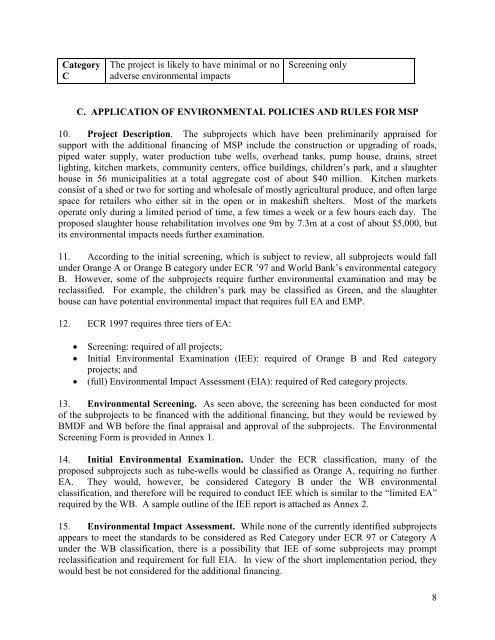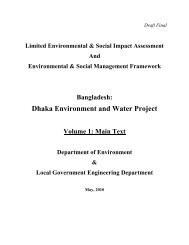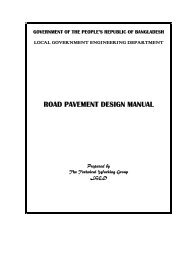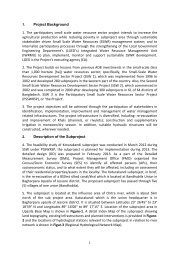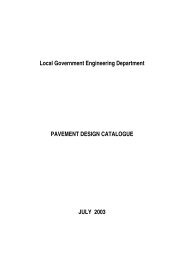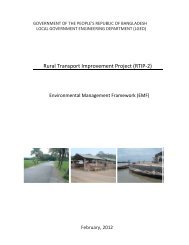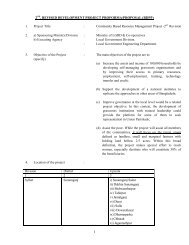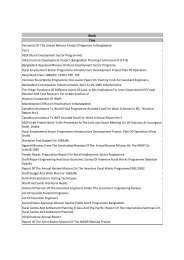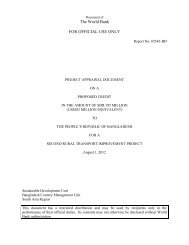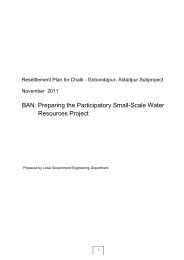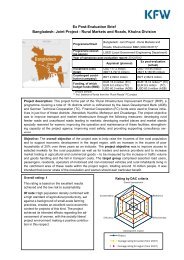environmental impact management framework (eimf) - LGED
environmental impact management framework (eimf) - LGED
environmental impact management framework (eimf) - LGED
You also want an ePaper? Increase the reach of your titles
YUMPU automatically turns print PDFs into web optimized ePapers that Google loves.
Category<br />
C<br />
The project is likely to have minimal or no<br />
adverse <strong>environmental</strong> <strong>impact</strong>s<br />
Screening only<br />
C. APPLICATION OF ENVIRONMENTAL POLICIES AND RULES FOR MSP<br />
10. Project Description. The subprojects which have been preliminarily appraised for<br />
support with the additional financing of MSP include the construction or upgrading of roads,<br />
piped water supply, water production tube wells, overhead tanks, pump house, drains, street<br />
lighting, kitchen markets, community centers, office buildings, children’s park, and a slaughter<br />
house in 56 municipalities at a total aggregate cost of about $40 million. Kitchen markets<br />
consist of a shed or two for sorting and wholesale of mostly agricultural produce, and often large<br />
space for retailers who either sit in the open or in makeshift shelters. Most of the markets<br />
operate only during a limited period of time, a few times a week or a few hours each day. The<br />
proposed slaughter house rehabilitation involves one 9m by 7.3m at a cost of about $5,000, but<br />
its <strong>environmental</strong> <strong>impact</strong>s needs further examination.<br />
11. According to the initial screening, which is subject to review, all subprojects would fall<br />
under Orange A or Orange B category under ECR ’97 and World Bank’s <strong>environmental</strong> category<br />
B. However, some of the subprojects require further <strong>environmental</strong> examination and may be<br />
reclassified. For example, the children’s park may be classified as Green, and the slaughter<br />
house can have potential <strong>environmental</strong> <strong>impact</strong> that requires full EA and EMP.<br />
12. ECR 1997 requires three tiers of EA:<br />
• Screening: required of all projects;<br />
• Initial Environmental Examination (IEE): required of Orange B and Red category<br />
projects; and<br />
• (full) Environmental Impact Assessment (EIA): required of Red category projects.<br />
13. Environmental Screening. As seen above, the screening has been conducted for most<br />
of the subprojects to be financed with the additional financing, but they would be reviewed by<br />
BMDF and WB before the final appraisal and approval of the subprojects. The Environmental<br />
Screening Form is provided in Annex 1.<br />
14. Initial Environmental Examination. Under the ECR classification, many of the<br />
proposed subprojects such as tube-wells would be classified as Orange A, requiring no further<br />
EA. They would, however, be considered Category B under the WB <strong>environmental</strong><br />
classification, and therefore will be required to conduct IEE which is similar to the “limited EA”<br />
required by the WB. A sample outline of the IEE report is attached as Annex 2.<br />
15. Environmental Impact Assessment. While none of the currently identified subprojects<br />
appears to meet the standards to be considered as Red Category under ECR 97 or Category A<br />
under the WB classification, there is a possibility that IEE of some subprojects may prompt<br />
reclassification and requirement for full EIA. In view of the short implementation period, they<br />
would best be not considered for the additional financing.<br />
8


